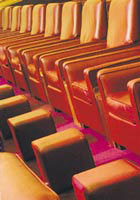Great comfort
Public seating needs to be both comfortable and durable. Hannah Booth reports

The importance of public seating to west London’s newly opened Electric Cinema is evident the moment you log on to its website to book tickets. There, taking centre-stage, is a photograph of Lyndon Design’s bespoke upholstered leather chair, clearly one of the renovated Edwardian cinema’s major selling points. ‘We designed unconventional seating for an unconventional cinema,’ explains Lyndon managing director Richard Pugh. Indeed, the hand-made, red leather armchairs in the auditorium – which totals 100 – incorporate not only a hinged, cuboid footstool, but are linked by American walnut wood drinks tables with built-in wine coolers. It’s a far cry from the cramped seating found in most high street cinemas, but then the Electric is not your average high street cinema. The auditorium houses a wine and cocktail bar with at-your-seat food service, and tickets top £10. ‘The Electric is all about having a fantastic experience,’ Pugh says. He presented Electric’s visionary owner Nick Jones with five seating prototypes before Jones decided upon the final model, which Pugh describes as a domestic armchair and cinema seat hybrid. ‘[Jones] is a real entrepreneur and deliberate in his aims. He was a specific, demanding, but extremely forward-thinking client and led the project from the start,’ Pugh says. Despite daily use and the threat of spillages from one too many Chardonnays, the hardy leather seating is nonetheless designed with a long life-span in mind. At a cost of around £5m, the Electric clearly can’t undergo too many refurbishments. By contrast, the public seating in Manchester’s Piccadilly station has a slightly shorter life-span. The station’s refurbishment programme should have been completed for the Commonwealth Games, but is still being finished. However, the seating system Ala, created by Spanish designer Josep Lluscà for manufacturer Oken, was installed last month on the station’s main concourse and platforms. Oken was commissioned by Railtrack to provide seating for several of its key stations, including Leeds Central and London Waterloo. Ala was selected for a number of reasons, explains Peter Loftus, director of Oken’s UK distributor, Office Images Interiors. ‘The seats are individually armed, which helps create a feeling of privacy, and the polished aluminium frame is easy to maintain,’ he says. Furthermore, the seats’ steel shells can be recoated and easily replaced. Ala seating in this type of environment will probably last up to 15 years, Loftus says. The Ala system has also been commissioned by Virgin’s travel centre at Manchester Piccadilly, to complement the concourse seating. The seat covers stand out in Virgin’s corporate red. Seating in a station is subject to far more rigorous use than a cinema, Loftus says. Mainline stations are usually open 24 hours, e e during which time around five different managers can be in charge of the space. Maintenance of a particular area, such as seating, can be easily overlooked as managers pass the buck, he adds. With airport seating, customers’ requirement go up a gear and comfort becomes paramount, according to Roger Ravenall, UK director of seating manufacturer Akaba. ‘International travellers can spend up to eight hours in a chair, so it’s got to be comfortable. The height and width of the seat are important, and it must offer the customer a bit more privacy than in, say, a railway waiting area,’ he says. To this end, seats should have wide table-like spaces between each unit. Clients expect to pay more for high-spec public seating such as this, he says. Airport seating can cost around £2000 for a four-seater, ‘which works out around £500 a bum’, he adds. The environment clearly dictates the type of seating that should be used. ‘If you’re sitting in an office reception area, you’ll be getting pretty fidgety after an hour. But you expect to wait around in an airport,’ Ravenall says. Similarly, in an art gallery, the criteria is less exacting again. ‘Art gallery seating must be designed to suit the architecture of the building. Seating, such as ergonomic benches, is usually used as it acts as a short-term “perch”,’ he adds. The lobby area of Manchester’s Urbis museum might appear to fit both these criteria. Opened earlier this year, Urbis incorporates the Aero seating system designed by Liévore-Altherr-Molina for Sellex, which was launched in the UK at Spectrum earlier this year. Aero is a bench system in extruded aluminium, more suited to ‘perching’. Aero has also been installed in the public reception area of Sir Norman Foster’s Greater London Assembly building in London, which opened in July. The building houses bespoke seating in its purpose-built, curved assembly chamber, too. Designed by Race Furniture, the seating had to meet a specific brief: it had to incorporate speakers to help distribute sound in the unusually shaped chamber without resorting to additional sound equipment. The auditorium is encircled by ascending ramps taking the public to the top of the building. The seat is manufactured in a mock-suede fabric, arguably more effective than the real thing, says Race design and technical manager Ian Coates. ‘The material is free of the natural defects found in suede, and also comes on a roll which helps its application,’ he says. It features a soft seat with a firm perimeter. The seating also forms part of the chamber’s natural ventilation system. It incorporates air grills in a ‘trough’ under each seat, which also hide a tangle of ugly cables and wiring. ‘The seats are individual one-offs, produced 250 times over,’ explains Coates. ‘We had to taper the armrest of each seat to enable them to fit round the corners of the curved space, and designed four different seat widths so they would sit together neatly. The layout was extremely complex,’ he adds. Race worked closely with Foster and Partners to ensure the seating became an ‘integral part of the surroundings’, adds Race commercial director Paul Williams. As Ravenall says, ‘comfort and durability comes first. The rest will follow’.
-
Post a comment




